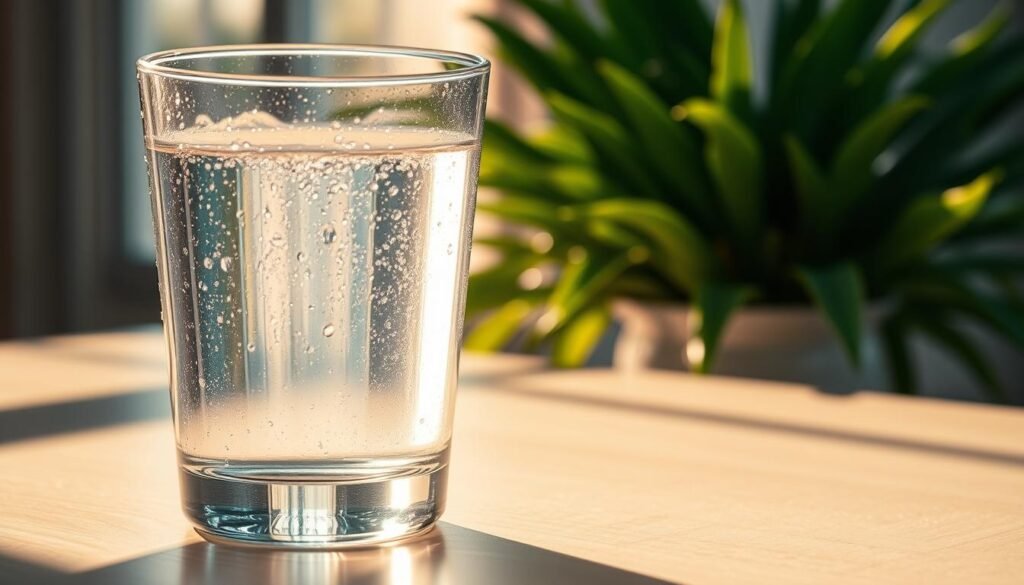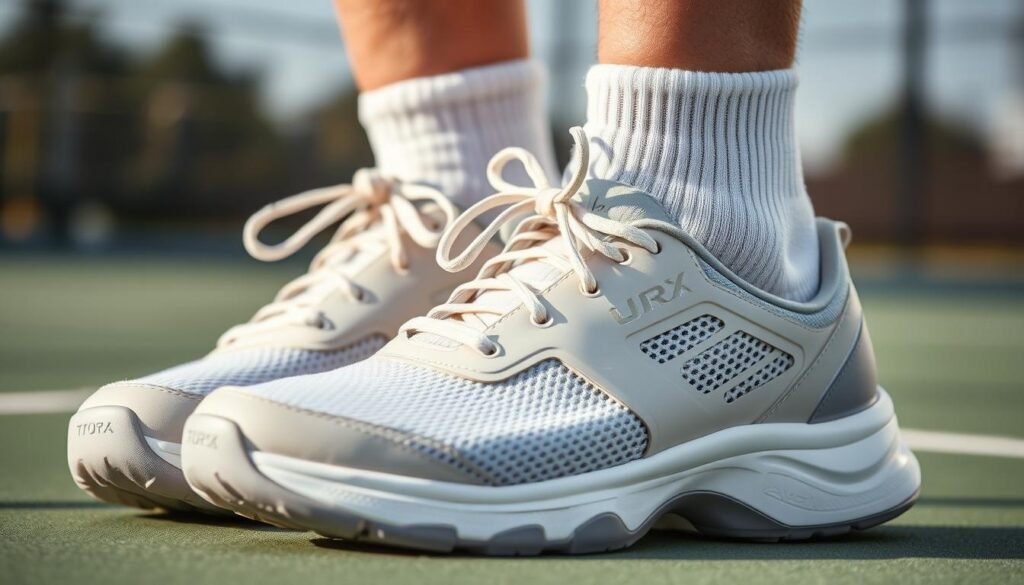How much can the right gear actually change my game on a scorching afternoon?
I want my Pickleball Outfit for Hot Weather to do more than look sharp. It must keep me cool, dry, and ready from the first serve to the last rally.
I focus on clothing and apparel that manage sweat, block sun, and move with me. That boosts my confidence and my performance on the court.
My selection goals are simple: stay light, maximize comfort, and pick pieces that let me react fast. I avoid heavy shorts and soggy tees that slow me down.
Later sections break down tops, bottoms, shoes, and accessories. I explain the materials and design features I trust, and how I test gear in real sessions so it holds up.
Choosing the right kit is an investment in consistent play, not just style. I’ll show you how to build a hot-weather-ready set that works as hard as you do.
Why hot-weather pickleball demands smarter apparel choices
When the mercury climbs, my wardrobe choices can make the difference between clear thinking and overheating. I need gear that helps manage heat and keeps my focus steady during long rallies.
How heat, sun, and sweat impact my performance on the court
High heat raises my body temperature quickly. That forces my heart and cooling systems to work harder and drains energy I need for fast footwork.
Direct sun adds UV exposure and extra heat load. Sunburn and prolonged glare slow reactions and can cause long-term skin harm.
Sweat is useful only if it evaporates. I pick fabrics that move moisture away so I feel light and unbothered while I play.
| Risk | Key Signs | Apparel action I take |
|---|---|---|
| Dehydration | Weak focus, slow reaction time | Light layers + easy access to fluids |
| Heat exhaustion / heat stroke | Dizziness, confusion, very high body temperature | Breathable, ventilated pieces and UPF protection |
| Sun damage | Sunburn, long-term skin risks | Hats, sleeves, and UPF-rated fabric |
Smart apparel reduces thermal strain so my decision-making stays sharp. I avoid heavy layers that trap heat and shorten how long I can play.
Choosing breathable, UPF-rated gear is not optional for safe, steady performance in summer weather.
Before I dress: managing body temperature and hydration
I focus on fluids and simple cooling steps before I get dressed so my session starts strong. A clear plan helps me avoid early fatigue and keeps my body temperature steady as the day warms.
My pre-, mid-, and post-game hydration plan to keep cool
I drink 16–20 oz of water 1–2 hours before I start. That sets a baseline and slows the drop in energy when the temperature rises.

During matches I sip 7–10 oz every 10–20 minutes. This steady routine prevents concentration lapses and helps me move faster on court.
- I rebuild after games with water or a low‑sugar electrolyte to replace sodium and potassium lost through moisture.
- I apply broad‑spectrum SPF 30+ to exposed skin and seek shade between points to lower direct sun load.
- I pack bottles, a cooling towel, and an electrolyte tab so the plan is easy to follow between rallies.
| Phase | Action | Why it matters |
|---|---|---|
| Pre-game | 16–20 oz water 1–2 hrs prior | Stabilizes temperature and reduces early fatigue |
| Mid-game | 7–10 oz every 10–20 mins | Keeps players sharp and prevents dips during games |
| Post-game | Water or low-sugar electrolyte | Replaces fluids and minerals to speed recovery |
I monitor cues—thirst, dizziness, and weight change—so I act before problems start. I also avoid sugary drinks that upset my stomach and pair drinking with shade and cool-downs to help my body cool faster and let me play another set.
Moisture-wicking fabrics that keep sweat away from my skin
I treat fabric choice as a performance decision: some textiles help me stay quick, others slow me down.
Polyester, nylon, and spandex blends that evaporate quickly
Moisture-wicking fabrics use hydrophobic fibers and capillary action to pull sweat to the fabric surface so it can evaporate quickly.
Polyester repels water and dries fast. Nylon adds durability and a smooth feel. Spandex gives stretch so I move without restriction.
Why cotton and heavy knits weigh me down
Cotton soaks up moisture and stays wet. That makes shirts feel heavy and increases friction during lateral movement.
I avoid thick knits on warm days and reserve them for cooler sessions or warmups.
- I prioritize moisture-wicking fabrics that move sweat away skin and keep me light.
- I check labels for blends that spread moisture across the surface and include antimicrobial finishes.
- I test hand-feel: if it feels spongy, it probably won’t dry fast or prevent chafing.
| Material | Key benefit | Best use |
|---|---|---|
| Polyester | Dries fast, repels moisture | Tops and base layers |
| Nylon | Durable, quick-dry feel | Shorts and reinforced panels |
| Spandex | Stretch and recovery | Fit areas needing mobility |
| Cotton | Comfort but holds water | Casual wear, not intense play |
Picking the right fabric stabilizes thermal comfort and keeps my timing sharp late in matches.
Breathability and ventilation: designs that move air, not just style
Good airflow in my gear can stop heat from stealing my focus during long matches. I judge tops by how well they let air pass where I produce the most heat.
I look for breathability in back panels, sides, and underarms. That targeted approach keeps my core cooler and my legs fresher as intensity rises.
Mesh panels, quick-dry construction, and airflow where I heat up most
I favor mesh at the back, along the sides, and underarm zones so air moves freely as I sprint and change direction. Zippered vents and small slits let me adjust ventilation mid-match.
Quick-dry fabric paired with open-knit panels keeps constant air exchange. That limits heat spikes and helps stabilize my temperature between sets.
UPF apparel to protect my skin and help regulate temperature
I choose UPF-rated materials for sun protection that also resists heat gain. Dense, UV-treated materials block rays while lighter colors reflect sunlight for a cooler feel.
- I inspect inner channels and perforations that guide air without losing structure.
- I check drape—stiff layers can block airflow, while engineered materials encourage movement of air.
- I test tops in warmups to confirm I feel circulation where I need it most.
| Feature | Placement | Benefit |
|---|---|---|
| Mesh panels | Back, sides, underarms | Targeted airflow where players overheat most |
| Zippered vents / slits | Upper chest or hem | Adjustable ventilation during rallies |
| Quick-dry fabric | Full garment | Maintains airflow and reduces temperature spikes |
| UPF-treated materials | Outer layer | Sun protection and steadier thermal feel |
Buyer’s checklist: Pickleball Outfit for Hot Weather
I use a short checklist to choose gear that keeps me cool and confident on sunny courts. Below I list the essentials I bring and why each item matters.
Tops: lightweight tees and tanks that pull moisture away fast
I pick tops with mesh panels, UPF protection, and quick-dry polyester blends in light colors. These clothing choices move moisture to the surface so sweat evaporates fast.
Bottoms: moisture-wicking shorts and skorts that prevent chafing
For bottoms I favor moisture-wicking shorts or skorts with breathable liners and secure pockets. Proper fit stops bind at the hips and cuts down on chafing during lateral movement.
Accessories: cooling towels, sleeves, hats/visors, and UV-rated sunglasses
I keep a cooling towel and arm sleeves I can wet between sets. I rotate sweat-wicking headbands, mesh caps, and UV-protective sunglasses with anti-fog lenses.
- I shortlist clothing features: moisture-wicking fabrics, mesh in heat zones, UPF, and light colors.
- I add gear that matters: cooling towels, wettable sleeves, and a visor or cap for shade.
- I verify seam placement, soft waistbands, and secure pockets so essentials don’t bounce.
| Item | Key feature | Why it matters |
|---|---|---|
| Tops | Mesh + UPF | Airflow and sun protection |
| Bottoms | Breathable liner | Reduces moisture and chafing |
| Accessories | Cooling + UV sunglasses | Faster recovery between points |
Shoes and socks that keep my feet cool, dry, and blister-free
My feet set the pace, so I treat shoes as an essential part of my cooling strategy. I pick lightweight court shoes with ventilated uppers and non‑marking soles built for quick lateral work.

Breathable court shoes with mesh uppers and non-marking traction
I look for engineered mesh uppers to boost breathability and let sweat escape instead of pooling near my toes. Midsole cushioning needs to stabilize movement without the springy feel of a running shoe.
- I insist on non‑marking, court-ready traction that grips during stops and starts without scuffing the surface.
- I match shoes with performance socks made from synthetic blends or merino wool that manage moisture and protect skin with padding in high-friction zones.
- I test fit late in the day, rotate pairs to dry fully, and replace insoles to keep shock absorption consistent.
| Component | Key feature | Benefit |
|---|---|---|
| Shoe upper | Engineered mesh | Airflow to reduce sweat and heat |
| Sole | Non‑marking traction | Stable stops on the court without scuffs |
| Midsole | Low‑bounce cushioning | Controlled movement and reduced roll |
| Socks | Mesh panels + padding | Moisture control, blister prevention, skin protection |
I remind players that a tuned shoe‑sock combo is a true performance tool. The right pairing keeps my feet cooler and fresher so my footwork stays sharp.
Fit, movement, and style: how I choose apparel that helps me play my best
I test gear by moving hard—if it limits me, it never makes it into my rotation.
I look for flexible blends like polyester/spandex that stretch without losing shape. Flat seams or bonded hems reduce friction against my body and cut chafing during long sessions.
Quick-dry construction and UPF-treated fabric are must-haves for outdoor play. Ventilation zones sit where I heat up most so airflow supports rapid recovery between points.
- I prioritize a fit that lets me move freely in all directions and test reach, twist, and sprints.
- I choose materials that stretch enough for explosive movements yet keep sleeves and hems in place.
- I balance clean style lines with function so my look supports comfort and performance.
- I confirm real-world support with lunges, overheads, and quick shuffles before I buy.
| Feature | What I check | Benefit |
|---|---|---|
| Waistbands & armholes | Secure without squeezing | Stay put while I move |
| Seams & hems | Flat or bonded | Less friction, more comfort |
| Fabric finish | Soft after wash, no pilling | Longer-lasting game-ready gear |
Conclusion
My final takeaway ties hydration, ventilation, and fit into one practical routine I can use every match.
I hydrate with 16–20 oz before play and sip 7–10 oz at regular intervals. After games I replace fluids with water or a low‑sugar electrolyte to speed recovery.
I pick clothing and materials that move moisture away so sweat can evaporate quickly. I favor polyester-rich blends, UPF apparel, hats or visors, and UV sunglasses to protect skin and keep temperature steadier.
I keep gear light: quick-dry shorts, breathable tops, cooling towels, and shoes with mesh uppers and stable traction. I avoid cotton in peak heat to cut chafing and damp weight against the body.
Pack smart and you stay cool, dry, and ready to play your best from first ball to last.
